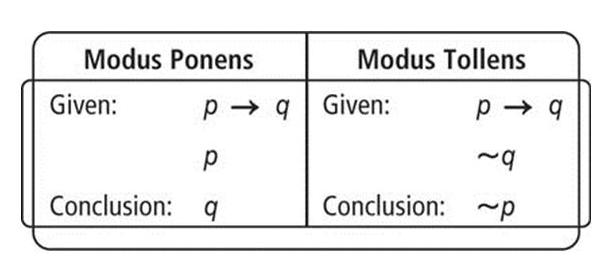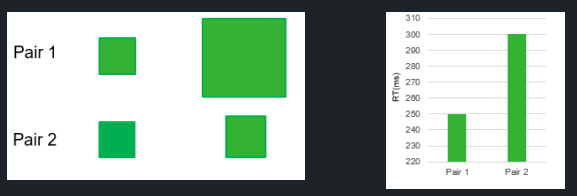Chapter 17 - Decisions, judgements, and reasoning
1/50
Earn XP
Description and Tags
Brain and Cognition
Name | Mastery | Learn | Test | Matching | Spaced |
|---|
No study sessions yet.
51 Terms
Syllogism
A three-statement logical form consisting of two premises followed by a conclusion.
For example:
Premise 1: All are A are B
Premise 2: All B are C
Conclusion: Therefore, all A are C
Belief Bias
The proneness of people to ignore the logical form of an argument and focus on their prior world knowledge.
For example:
Premise 1: All poodles are animals
Premise 2: All animals are wild
Conclusion: Thus, all poodles are wild
(People say the conclusion is wrong as their world knowledge does not accord with this conclusion)
Conditional Reasoning
A type of logical reasoning that involves an if-then relationship between statements. If P, then Q
Antecedent
The if clause in a conditional reasoning statement. For example, if it rains, then the streets will be wet.
Consequent
The then clause in a conditional reasoning statement. For example, if it rains, then the streets will be wet.
Modus Ponens
Affirming the antecedent. Saying that the antecedent is true. (Valid inference)

Modus Tollens
Denying the consequent. Saying that the consequent is not true. (Valid inference)

illicit conversion
All cats are mammals
All mammals are cats
(illicit conversion is committed, because it implies that all mammals are cats, which is not true)
Confirmation bias (Searching for Positive Evidence)
A cognitive bias where individuals focus on information that confirms their existing beliefs.
Mental models
Mental representations of meanings of the terms in reasoning problems.
Distance effect / discriminability effect
The greater the difference between the two stimuli, the faster the decision that they differ.

Hypothesis testing
The essence of hypothesis testing is to conclude that the if portion (the null hypothesis) is false based on an outcome that denies the consequent of the null hypothesis
If-then problems
Reasoning tasks that involve conditional statements (For example, "If P, then Q")
Heuristic
An informal method or guideline used to make decisions or judgments, often a 'rule of thumb'.
Conjunction Fallacy
The mistaken belief that specific conditions are more probable than a single general one.
For example:
Serena likes football
Serena is a Bears fan who likes football
SNARC Effect
A cognitive phenomenon where responses to smaller numbers are quicker with the left hand and larger numbers with the right.
Psychophysics
The study of the relationship between physical stimuli and the psychological experiences they evoke.
Just Noticeable Difference (JND)
The smallest amount by which two stimuli must differ for the difference to be detected.
Symbolic comparisons
Comparisons not between two physical objects or stimuli, but between two mental symbols.
Symbolic distance effect
Differences between symbols are judged more rapidly when they differ considerably on some dimension, for example through shape.
Semantic Congruity Effect
Faster decision-making when the dimension judged matches the semantic dimension.
Number magnitude
Banks. Work on judgements of numerical magnitude suggests that the mental representation of numerical magnitude is nonlinear.
Imagery
The formation of mental pictures or representations of objects, events, or ideas.
Representativeness Heuristic
When we judge the probability of uncertain events, we do so on the basis of the event’s representativeness.
Availability Heuristic
A cognitive bias where individuals judge the frequency of events based on how easily examples come to mind.
Falsification Principle
A principle asserting that to prove a theory false, one must demonstrate that its predictions do not hold.
Semantic orderings
The tendency to assume that small samples will be as representative of the population from which they are drawn as large samples.
Geographical distance
The farther away cities are, the closer together they are in mental representation, according to a study by Hoyoak and Mah.

A procedure that is guaranteed to provide the correct answer if carried out correctly. For example, a formula
Normative model
A model that describes how people should behave or make decisions if they were perfectly rational.
Descriptive model
A model that describes how people actually behave or make decisions, often highlighting deviations from normative models due to cognitive limitations and biases.
Insensitivity to sample size
The tendency to assume that small samples will be as representative of the population from which they are drawn as large samples.
Law of small numbers
The mistaken belief that small samples should resemble the population from which they are drawn.
Law of large numbers
The principle that as the number of observations of a random phenomenon increases, the sample mean approaches the true mean of the underlying distribution.
Generalized beliefs about particular groups of people, often based on oversimplification or inaccurate information.
Mental acceptances that something is true or real.
Availability heuristic
A mental shortcut that relies on immediate examples that come to a given person's mind when evaluating a specific topic, concept, method or decision. We tend to overestimate the likelihood of events that are easily recalled.
Anchoring and adjusting
A cognitive bias that describes the common human tendency to rely too heavily on the first piece of information offered (the "anchor") when making decisions. Subsequent judgments and decisions are then made by adjusting away from that anchor, but often insufficiently.
Heuristic familiarity bias
Judging events as more frequent/important as they are more familiar.
Salience / vividness bias
Type of availability heuristic. It refers to the tendency to overestimate the importance of information that stands out and is easily recalled, often due to its emotional or vivid nature.
Simulation heuristic
A mental strategy for evaluating events based on how easily one can imagine them unfolding in a particular way. It's often used for counterfactual thinking.
Counterfactual reasoning
Thinking about past events and imagining how they might have turned out differently.
Downhill change
A type of counterfactual thinking where individuals imagine how an outcome could have been worse.
Blaming the victim
The tendency to attribute responsibility or blame to the victims of crime or misfortune.
Hindsight bias
The tendency, after an event has occurred, to see the event as having been predictable, despite there having been little or no objective basis for predicting it. Also known as the "I-knew-it-all-along" phenomenon.
Simulation heuristic
A mental strategy for evaluating events based on how easily one can imagine them unfolding in a particular way. It's often used for counterfactual thinking.
A decision-making strategy that aims for a satisfactory or "good enough" result, rather than the optimal solution. This often occurs when time or cognitive resources are limited.
Recognition heuristic
A heuristic used when people must make judgments between alternatives. If one alternative is recognized and the other is not, people infer that the recognized alternative has the higher value with respect to the criterion.
“Take the best” conjunction fallacy
A lexicographic decision strategy where choices are made by sequentially considering the most important attribute. If one option is better on that attribute, it is chosen. If there is a tie, the next most important attribute is considered, and so on.
Naive physics
People's intuitive, common-sense understanding of the physical world, which often deviates from actual physical laws.
Prototypicality heuristic
Categorizing objects or events based on how well they match a typical or average example (prototype) of that category.